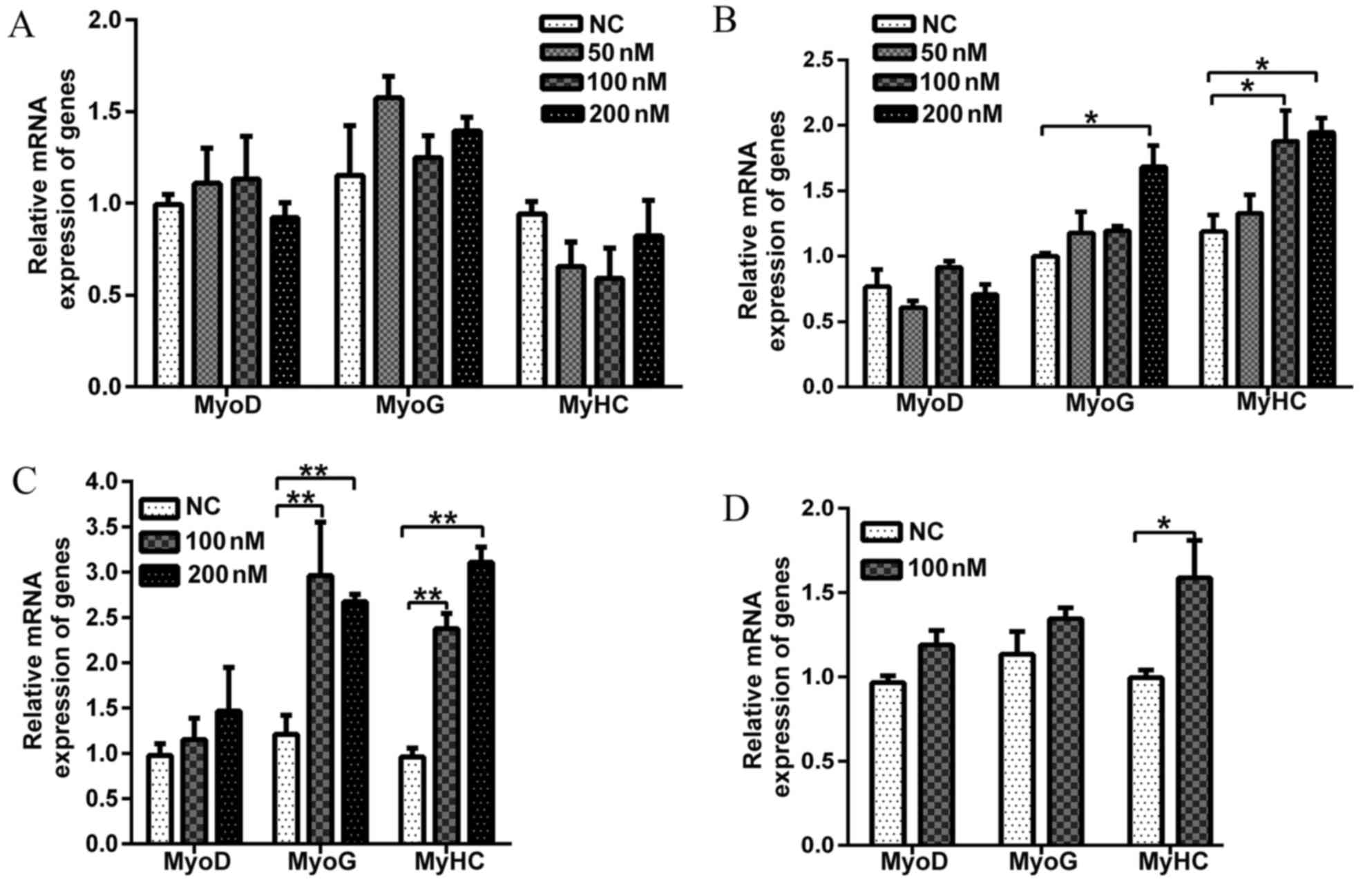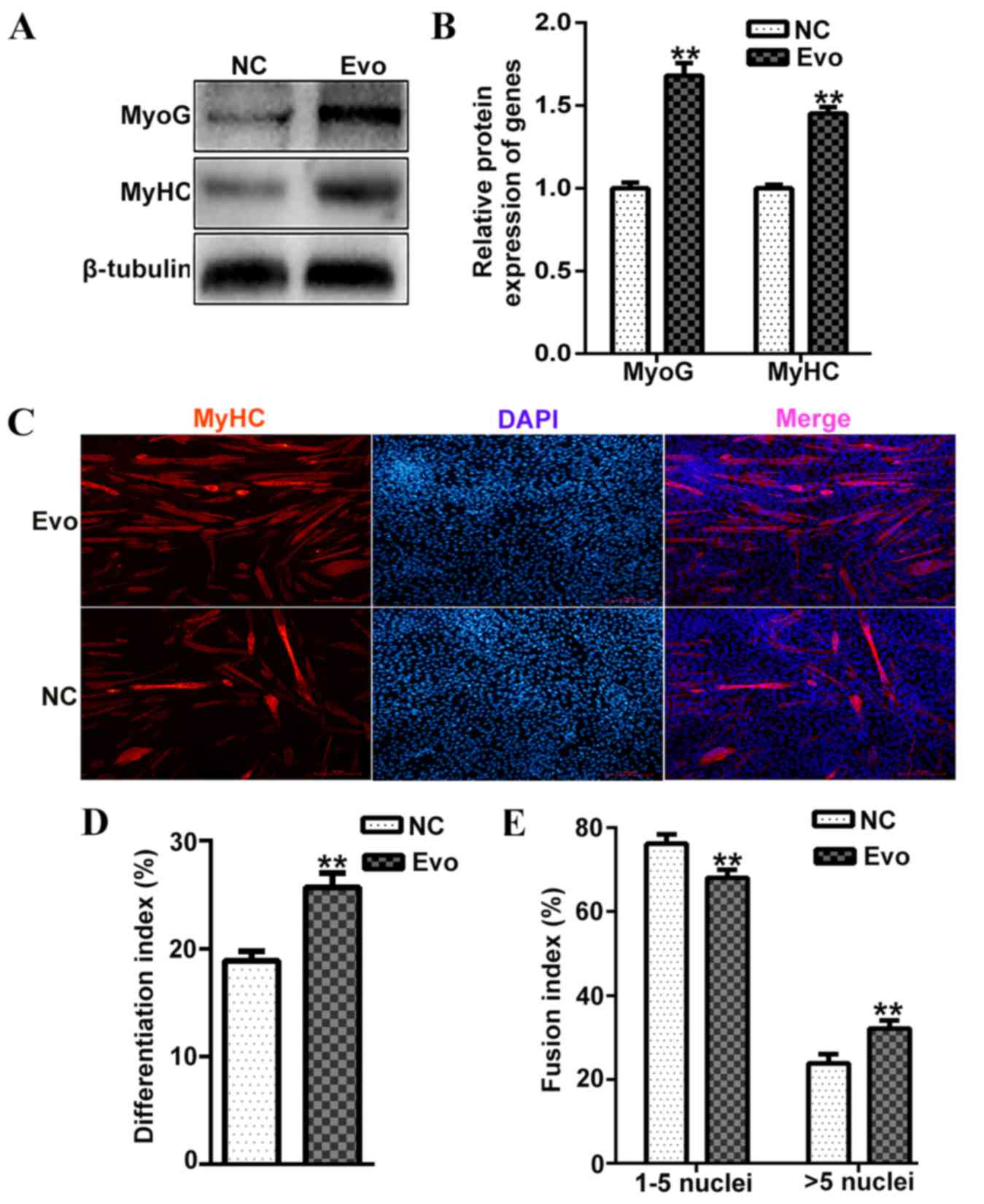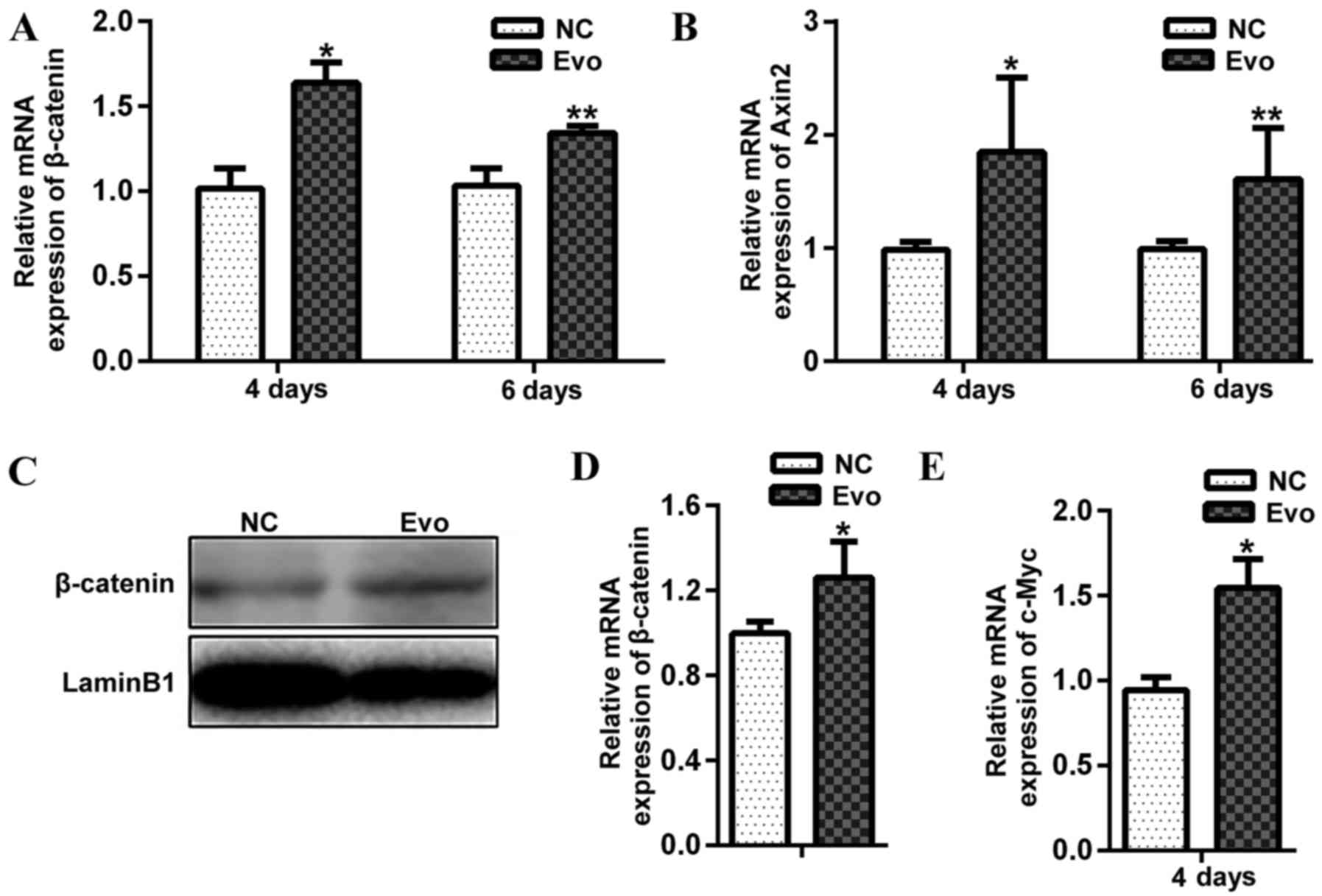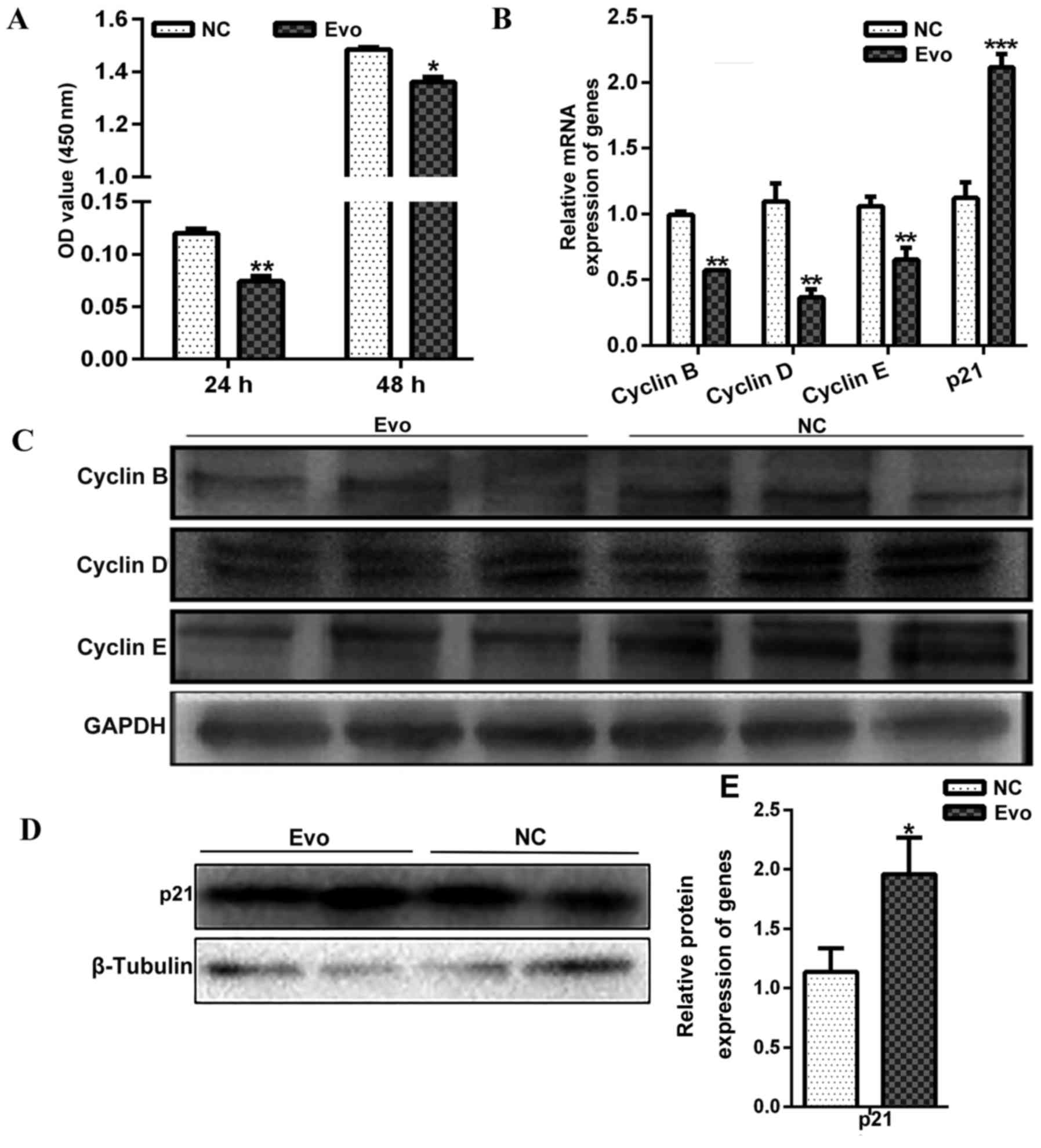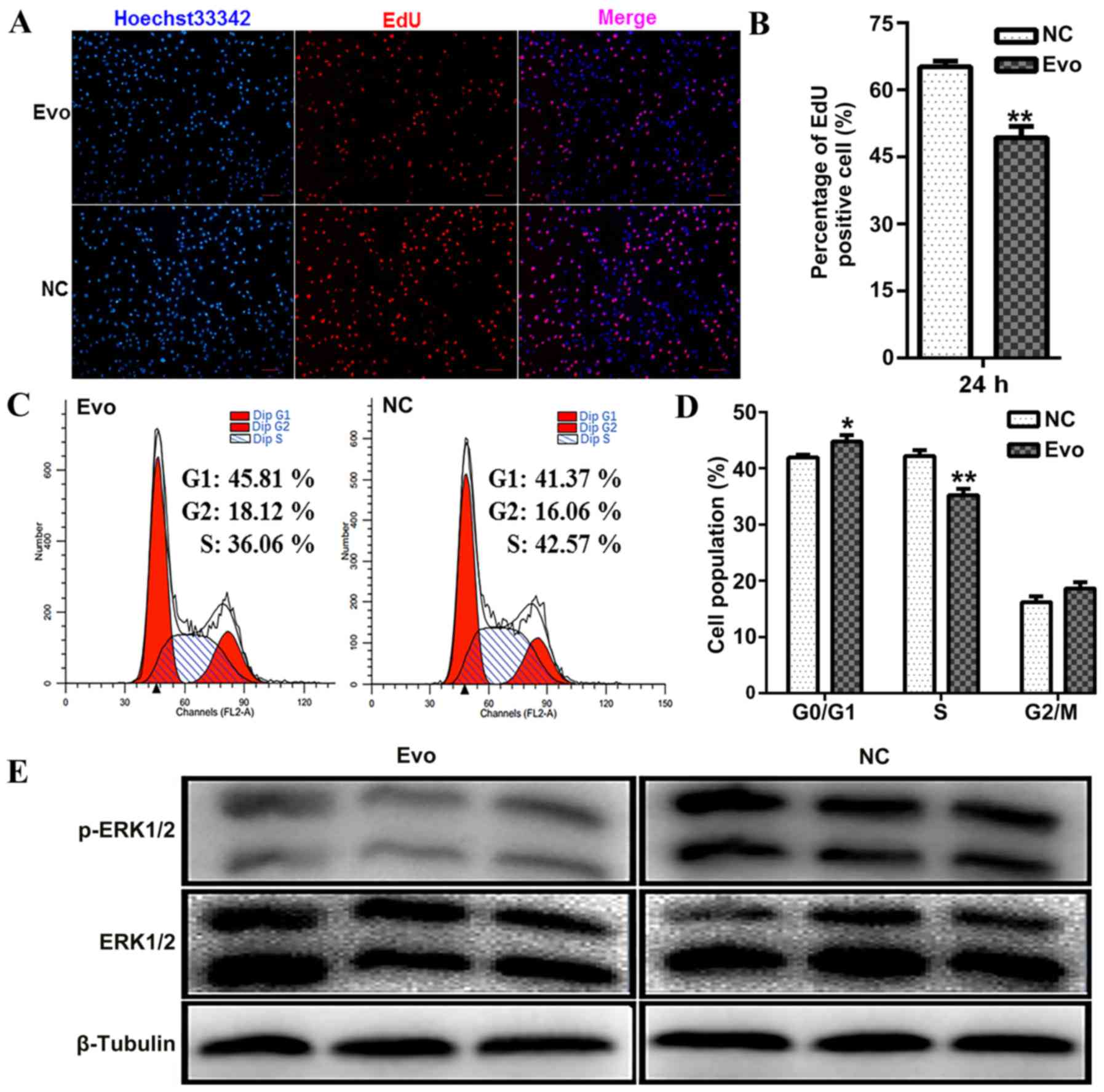Evodiamine promotes differentiation and inhibits proliferation of C2C12 muscle cells
- Authors:
- Published online on: December 13, 2017 https://doi.org/10.3892/ijmm.2017.3321
- Pages: 1627-1634
Abstract
Introduction
Chinese herbal medicine has become a popular field of study. For instance, artemisinins inhibit the development of a broader age range of parasites than quinine and other antimalarial drugs (1). Myricetin has a negative effect on proliferation and induces apoptosis in gastric cancer cells (2). Evodiamine (Evo) is a quinozole alkaloid constituent of Evodia rutaecarpa extracted from the fruit of Evodia fructus (dried fruits of Evodia rutaecarpa Bentham, Rutaceae) (3,4). Evodia fruits, known as 'Wu-Chu-Yu', have been prescribed for the treatment of headaches, thoracicoabdominal pain and vomiting caused by a cold or a cold constitution in both traditional Chinese and Japanese medicine. The Chinese literature refers to Evodia fruits as a 'hot nature' herb, which is the same category chilli peppers belong to. Previous studies have reported that Evo exhibits antitumor, anti-inflammatory and vasorelaxant properties (5–7). Furthermore, was demonstrated to Evo activate extracellular signal-regulated kinase (ERK) signalling, which inhibited adipogenesis (8). However, at present, the effect of Evo on myogenesis has not been reported.
Skeletal muscle accounts for 40% of the total human body mass. Skeletal muscle has extensive metabolic and functional plasticity and a robust regenerative capacity (9). During myogenesis, there are two phases of proliferation and differentiation, which are precisely regulated by an ordered set of cellular events. The MyoD family, a basic helix-loop-helix, includes four members [myogenic differentiation 1 (Myod), myogenic factor 5, Myogenin (MyoG) and myogenic factor 6], are the major molecular mediators regulating skeletal myogenesis (10,11). C2C12 cells are regarded as a bioassay system in vitro. At present, this model has been used extensively in studies of the effects of muscle growth factors on muscular atrophy and hypertrophy, cell replication and apoptosis (12,13).
Wnt/β-catenin signalling has a vital role in the development of embryonic muscle and proliferation of satellite cells during skeletal muscle regeneration (14,15). β-catenin translocation to nucleus activates Wnt signalling pathway, and WNT3a enhances the myogenic differentiation of C2C12 muscle cells (16). The association of Axin and glycogen synthases kinase (GSK) 3β disrupts the β-catenin complex, which results in the accumulation of β-catenin in the nucleus and activation of target genes through displacing transcriptional repressors. (17).
In normal mammalian cells, ERK1/ERK2 has an important central role in the regulation of cell proliferation and is required for cells to move from G0 through G1 and into S phase (18). In 3T3-L1 preadipocytes, Evo activates ERK phosphorylation, which in turn inhibits adipocyte differentiation (8).
Given that Evo regulates the proliferation, differentiation and apoptosis of multiple cell types and that Wnt/β-catenin signalling is essential for myogenesis, we hypothesize that Evo may affect C2C12 myoblast differentiation through the Wnt/β-catenin signalling pathway. In the present study, it was demonstrated that Evo promotes the differentiation of C2C12 cells and inhibits proliferation.
Materials and methods
Cell culture
C2C12 mouse myoblast cell line (American Type Culture Collection, Manassas, VA, USA) was cultured in Dulbecco's modified Eagle's medium (DMEM; Invitrogen; Thermo Fisher Scientific, Inc., Waltham, MA, USA) supplemented with 10% (v/v) foetal bovine serum (HyClone; GE Healthcare Life Sciences, Logan, UT, USA), 2 mM glutamine and 1% (v/v) penicillin/streptomycin [growth medium, (GM)]. Cells were cultured at 37°C with 5% CO2. When the cell density reached 90% confluence, the GM was replaced with a differentiation medium (DM), which was DMEM supplemented with 2% (v/v) horse serum (HyClone; GE Healthcare Life Sciences), 2 mM L-glutamine, and 1% (v/v) penicillin/streptomycin solution. The media was changed every 2 days. Evo (purity >98.0%; Xi'an Guanyu Bio-Tech Co., Ltd., Xi'an, China) was diluted to 50, 100 and 200 nM using dimethyl sulfoxide (DMSO).
Evo supplementation and DMSO negative control
To determine the effect of Evo on the differentiation of C2C12, there were two Evo treatments. Initially, different concentrations (50, 100 and 200 nM) of Evo were added to the DM on differentiation day 0, and then the experiments were performed on differentiation day 2 or 4. Subsequently, following differentiation for 2 days, differentiation concentrations (100 and 200 nM) of Evo were added to the DM, and experiment were performed on differentiation day 4 or 6. To determine the effect of Evo on the proliferation of C2C12, GM was supplemented with Evo when the cell density reached 30–40%.
RNA extraction and reverse transcription-quantitative polymerase chain reaction (RT-qPCR)
Total RNA was extracted using a TRIzol® reagent (Life Technologies; Thermo Fisher Scientific, Inc.). The RNA quality and concentration were determined using agarose gel electrophoresis and NanoDrop 2.0 (NanoDrop Technologies; Thermo Fisher Scientific, Inc., Wilmington, DE, USA), respectively. Then, 1 µg of the total RNA was processed into single-stranded cDNA using an RT kit (Takara Biotechnology Co., Ltd., Dalian, Chin). RNA (1 µg) was reverse transcribed using PrimeScript RT reagent kit with gDNA Eraser. The RT program include two steps as follows: 42°C for 2 min, followed by 15 min at 37°C and 85°C for 5 sec. qPCR was performed using a SYBR®-Green kit (Takara Biotechnology Co., Ltd.) in triplicate on a Bio-Rad iQTM5 (Bio-Rad Laboratories, Inc., Hercules, CA, USA). The qPCR program was as follows: 95°C for 30 sec, followed by 40 cycles of 5 sec at 95°C and 30 sec at 60°C. The relative mRNA expression level was normalized to GAPDH. The 2−ΔΔCq algorithm was employed to estimate the relative expression level of each gene (19). Primer sequences are listed in Table I.
Flow cytometry
C2C12 cells were seeded in 60 mm dishes (1.6×105 cells per dish). At 24 h after supplementation with Evo, when the cell density reached 80% confluence, proliferating myoblasts were washed three times with cold phosphate-buffered saline (PBS) and fixed in 70% ethanol at −20°C overnight. Following centrifugation at 476 × g, at 4°C for 5 min, the supernatants were discarded, and the cells were washed with PBS twice and resuspended in 0.5 ml 50 µg/ml propidium iodide (Dojindo Molecular Technologies, Inc., Kumamoto, Japan) solution containing 0.2% (v/v) Triton X-100 and 100 µg/ml RNase A for 30 min at 4°C. The cells were then tested with a flow cytometry instrument (FACSCalibur; BD Biosciences, Franklin Lakes, NJ, USA), and data were analysed with the ModFit software (LT4.1; Verity Software House Inc., Topsham, ME, USA). The proliferative index indicates the proportion of mitotic cells from a total of 20,000 cells examined.
Proliferation assay
Labelling with 5-ethynyl-2′-deoxyuridine (EdU) is regarded as a marker that can detect DNA synthesis. At 24 and 48 h after supplementation with Evo, 10 µM EdU (Guangzhou RiboBio Co., Ltd., Guangzhou, China) was added into the GM and incubated for 4 h. All the procedures were performed according to the manufacturer's protocol. Cell nuclei were stained with Hoechst 33342 (Invitrogen; Thermo Fisher Scientific, Inc.) at a concentration of 5 µg/ml for 10 min. Subsequently, EdU-positive cells were visualized under a fluorescence microscope (Nikon Corporation, Tokyo, Japan). The percentage of positive cells (EdU-staining cells/total number of cells) was then calculated.
Western blot analysis
C2C12 cells were rinsed twice with ice-cold PBS. Total and nuclear proteins of C2C12 cells were extracted using ice-cold lysis buffer (radioimmunoprecipitation assay buffer; Beyotime Institute of Biotechnology, Haimen, China) including a protease inhibitor (Pierce; Thermo Fisher Scientific, Inc.). The lysates were centrifuged (5,712 × g) at 4°C for 15 min, and then 5X protein loading buffer was added to the lysates prior to full denaturation in boiling water for 10 min. A total of 25 µg of protein (quantified using the BCA Protein Assay kit; cat. no. CW0014; CWBIO, Beijing, China) were electrophoresed on a 12% SDS-polyacrylamide gel and transferred to a polyvinylidene difluoride membrane (Cell Signalling Technology, Inc., Danvers, MA, USA). The membrane was blocked in 5% (w/v) skim milk at room temperature for 2 h and then incubated at 4°C overnight with primary antibodies, including anti-MyoG (ab124800; Abcam, Cambridge, UK), muscle myosin heavy chain (MyHC; AF2387; R&D Systems, Minneapolis, MN, USA), β-catenin (bs-1165R; Bioss, Beijing, Chin), lamin B1 (ab16048; Abcam), ERK1/2 (8544; Cell Signalling Technology, Inc.), anti-p-ERK1/2 (9101; Cell Signalling Technology, Inc.), p21 (BA0272; Wuhan Boster Biological Technology, Ltd., Wuhan, China) and GAPDH (A00227; Wuhan Boster Biological Technology, Ltd.). The next day, the membranes were washed with TBST (20% Tween) and incubated with goat anti-mouse or anti-rabbit secondary antibodies [HRP-conjugated goat anti-mouse IgG (BA1050) and HRP-conjugated goat anti-rabbit IgG (BA1054); Wuhan Boster Biological Technology, Ltd.] at room temperature for 2 h. The membranes were washed three times with TBST and then exposed using a ChemiDoc XRS imaging system (Bio-Rad Laboratories, Inc.). Immobilon Western Chemiluminescent HRP substrate (WBKLS0500; Millipore Corporation, Billerica, MA, USA) was used to produce signal to detect western blot results. The captured images were analysed by Image Lab software (Bio-Rad Laboratories, Inc.). The protein bands were quantified using the Image J program (version 1.4.3.67; National Institutes of Health, Bethesda, MA, USA). The protein level of whole cell lysates was normalized against the expression of GAPDH and β-tubulin (KM9003T; Sungene Biotech, Tianjing, China), whereas the protein level of nuclear lysates was normalized against the expression of lamin B1.
Cell counting kit-8 (CCK-8) detection
C2C12 were seeded in 96-well plates at 2×103 cells per well in 100 µl GM. At 24 and 48 h after supplementation with Evo, 10 µl CCK-8 (Beyotime Institute of Biotechnology) was used to measure the cell proliferation index according to the manufacturer's instructions. The absorbance was quantified on a microplate reader (PerkinElmer Inc., Waltham, MA, USA). This experiment was independently repeated at least three times.
Immunocytofluorescence analysis
At 4 days post-myogenic differe ntiation, C2C12 cells were washed three times with cold PBS and fixed with 4% (w/v) paraformaldehyde for 30 min at room temperature. 0.5% (v/v) Triton™ X-100 (Sigma-Aldrich; Merck KGaA, Darmstadt, Germany) was used for permeabilization for 20 min at room temperature. The cells were then blocked in 5% (w/v) bovine serum albumin diluted in PBS. After blocking for 1 h at room temperature, the cells were incubated with anti-MyHC antibody (1:200 in TBST; MAB4470; R&D Systems China Co., Ltd., Shanghai, China) at 37°C for 2 h, followed by incubation with Alexa Fluor® 568-labelled secondary antibody (cat. no. a-11079; Invitrogen; Thermo Fisher Scientific, Inc.) at 37°C for 1 h. The nuclei were labelled with DAPI (1:1,000 in PBS; Roche Diagnostics, Basel, Switzerland) for 10 min at room temperature. Images were captured using a Nikon TE2000 microscope (Nikon Corporation). The differentiation index was determined as the percentage of MyHC-positive nuclei among total nuclei. The numbers of myotubes with 1–5 and 5 nuclei were counted and averaged among three images per treatment.
Statistical analysis
Each experiment was repeated three times independently, and each independent repeat was performed in triplicate. All experimental data are presented as the mean ± standard error and all figures were produced with GraphPad Prism 5 (GraphPad Software, Inc., La Jolla, CA, USA) One-way analy sis of variance followed by LSD and Duncan post hoc tesst in SPSS 18.0 software was used to perform the variance analysis and significance test. P<0.05 was considered to indicate a statistically significant difference.
Results
Evo promotes C2C12 myogenic differentiation
To determine the effect of Evo during the early phase of C2C12 differentiation, Evo was added to the DM on differentiation day 0. Fig. 1A demonstrates that the different concentrations of Evo did not significantly influence myogenic differentiation on day 2 post-differentiation. In order to determine the effect of long term treatment on C2C12 differentiation, Evo was added to DM for 4 days. Fig. 1B demonstrates that 50 nM Evo did not alter the mRNA expression of myogenic marker genes (MyoD, MyoG and MyHC). However, compared with the control treatment, 100 nM Evo significantly increased the expression of MyHC, a marker of late stage of muscle differentiation. Compared with the control, 200 nM Evo significantly increased the mRNA expression of MyoG and MyHC (Fig. 1B). The expression of MyoD, a well-known marker of early myogenic stage, was not changed by Evo addition. Therefore, Evo may positively impact the middle and late stages of C2C12 differentiation.
Subsequently, Evo was added either at 100 or 200 nM to DM on differentiation day 2. The mRNA expression levels of two myogenic marker genes (MyoG and MyHC) were increased >2.5-fold, compared with those of the negative control (Fig. 1C). Similarly, the same treatment was extended to differentiation day 6 (Fig. 1D), and 100 nM Evo increased mRNA expression of MyHC but did not alter the expression of MyoD and MyoG compared with the control group(Fig. 1D).
These results indicated that Evo treatment increases the mRNA expression of MyoG and MyHC. Additionally, the protein levels of MyoG and MyHC were significantly increased compared with the control on differentiation day 4 (Fig. 2A and B). The population of myotubes was also markedly increased by Evo compared with the control (Fig. 2C). Furthermore, the index of differentiation (Fig. 2D) and fusion (Fig. 2E) were also increased in cells treated with 100 nM Evo compared with the negative control. Thus, 100 nM Evo was selected as an appropriate concentration for further experiments. These results indicated that Evo had a positive effect on C2C12 differentiation at the middle and late stage.
Effect of on Wnt/β-catenin signalling in differentiating C2C12
To determine whether Evo promotes myogenesis via Wnt/β-catenin signalling Evo was added to DM on differentiation day 2. On differentiation day 4 and 6 Axin2 transcription and the nuclear translocation of β-catenin were determined, which are two indicators of Wnt/β-catenin activity. Evo treatment significantly increased the mRNA expression of β-catenin and Axin2 at day 4 and 6 of differentiation compared with the negative control (Fig. 3A and B). Evo treatment significantly increased the level of nuclear β-catenin (Fig. 3C and D). In addition, the mRNA expression of c-Myc, which is a known target of the canonical Wnt/β-catenin signalling pathway, was significantly upregulated in cells treated with Evo compared with the control (Fig. 3E). These results suggested that Evo promotes C2C12 differentiation through activation of the Wnt/β-catenin signalling pathway.
Proliferation of C2C12 myoblasts is repressed by Evo treatment
To investigate the effect of Evo on C2C12 myoblast proliferation, proliferation assays were performed in C2C12 cells by adding 100 nM Evo at different times. CCK-8 kit assays indicated that Evo decreased C2C12 cell proliferation after 24 and 48 h treatment compared with the control (Fig. 4A).
Additionally, mRNA expression analyses of genes associated with proliferation revealed that mRNA expression of Cyclin B (sc-166152; Santa Cruz Biotechnology, Santa Cruz, CA, USA), Cyclin D (BM4272; Wuhan Boster Biological Technology, Ltd.) and Cyclin E (sc-377100; Santa Cruz Biotechnology) were significantly decreased compared with the control after 24 h treatment (Fig. 4B). However, the mRNA expression of p21, a well-known negative regulator of the cell cycle, was significantly increased by Evo (Fig. 4B). The protein levels of the above genes were also detected by western blotting, and the results with consistent with the level of mRNA expression (Fig. 4C–E).
To further examine the direct effect of Evo on C2C12 proliferation, EdU incorporation was detected as an estimate of cell proliferation at 24 h. EdU is a thymidine analogue that can be inserted in nascent DNA molecules at the cell proliferation stage. After 24 h of treatment with Evo, the percentage of EdU-positive cells was significantly lower in the Evo-treated group compared with the control group (Fig. 5A and B). Additionally, proliferation analysis was performed using flow cytometry, which indicated that Evo led to cell-cycle delay with the fraction of S-phase cells decreased by Evo and the G0/G1 phase proportion increased by Evo (Fig. 5C and D).
Finally, whether Evo could affect ERK1/2 phosphorylation in proliferating C2C12 cells was determined. Western blotting demonstrated that Evo markedly inhibited phosphorylation of ERK1/2 (Fig. 5E). Therefore, we hypothesize that Evo may partially function by inhibiting the activity of the ERK pathway to repress C2C12 myoblast proliferation.
Discussion
In the present study, it was aimed to investigate the effects of Evo on C2C12 myoblasts. Three different concentrations of Evo (50, 100 and 200 nM) were used initially. On day 2 of differentiation, the mRNA expression level of MyoD, MyoG and MyHC was examined. However, Evo had no effect on the mRNA expression of the markers gene. This finding suggested that Evo does not affect early myogenic differentiation. On day 4 of differentiation, the high concentration of Evo significantly increased the mRNA expression of MyoG and MyHC, which are markers of middle and later differentiation stages in C2C12 myoblasts, respectively. Based on these findings, Evo does not have any influence on the mRNA expression of MyoD, a skeletal muscle-specific early transcription factor that has a transcriptional regulation effect on the myogenic program (20). Therefore, we hypothesized that Evo may use other mechanisms to initiate myogenic differentiation. At 2 days post-differentiation of C2C12 cells, 100 or 200 nM Evo was added to the DM. Consistent with expectations, the mRNA expression and protein levels of MyoG and MyHC were dramatically increased compared with the negative control at 4 days of differentiation, although the effect was not concentration dependent. Further confirmation of the above findings was provided by immunocytofluorescence analysis of MyHC expression in myotubes at 4 days of differentiation. Evo treatment markedly induced the expression of MyoG and MyHC, and increased the formation of myotubes. Analysis was continued to 6 days, and MyHC expression was remained significantly increased at this time point. Day 6 is the late period of differentiation for C2C12 cells, MyoD and MyoG expression was not significantly increased by Evo at this stage. These results indicate that Evo has an important effect on C2C12 myogenic differentiation.
The Wnt family of signalling molecules consists of 21 secreted glycoproteins. Wnt signalling includes canonical, planar-cell-polarity and calcium-dependent pathways (21). Wnt/β-catenin signalling initiates myogenic differentiation of satellite cells by replacing Notch signalling, which is critical for self-renewal of satellite cells through the inhibition of GSK-3 (22). In gastric cancer stem cells, Evo treatment suppressed the Wnt/β catenin signalling pathway to inhibit proliferation (7). Notably, the results of the current study indicated that Evo increased the nuclear translocation and accumulation of β-catenin, and activated the transcription of downstream genes, Axin2 and c-Myc, which are two indicators of Wnt/β-catenin signalling activity (23,24). The differing results may be due to the different cell types used.
The role of Evo has already been extensively investigated in various cell types. In 3T3-L1 preadipocytes, Evo activated the epidermal growth factor receptor-protein kinase Cα-ERK signalling pathway to inhibit adipogenesis (8). However, the data of the current study indicated that Evo inhibited the phosphorylation of ERK. The opposing result that was reported previously could be due to the use of different cell types. In hyperlipidemic HepG2 cells, Evo exhibited anti-lipogenic and anti-gluconeogenic effects through activation of human constitutive androstane receptor (25). In tumour cells, Evo promotes anti-proliferative effects and induces cell apoptosis (26–28). Evo inhibited the growth of DU145 and PC3 prostate cancer cell lines via accumulation at the G2/M phase and an induction of apoptosis (29). Evo has a negative effect on angiogenesis by inhibiting vascular endothelial growth factor expression and ERK phosphorylation (30). These results support that Evo typically has a negative effect on cell proliferation and that the ERK pathway may be involved in this process.
In conclusion, the findings of the current study demonstrate that Evo can positively regulates differentiation and suppresses the proliferation of C2C12 myoblasts. Evo may be a novel therapeutic agent for enhancing muscle growth.
Acknowledgments
The present study was granted by the Fundamental Research Funds for the Central Universities (grant nos. 2452015278 and 2452017079) and the National Science and Technology Major Project of China (grant no. 2016ZX08006003).
References
|
White NJ: Qinghaosu (artemisinin): The price of success. Science. 320:330–334. 2008. View Article : Google Scholar : PubMed/NCBI | |
|
Feng J, Chen X, Wang Y, Du Y, Sun Q, Zang W and Zhao G: Myricetin inhibits proliferation and induces apoptosis and cell cycle arrest in gastric cancer cells. Mol Cell Biochem. 408:163–170. 2015. View Article : Google Scholar : PubMed/NCBI | |
|
Pearce LV, Petukhov PA, Szabo T, Kedei N, Bizik F, Kozikowski AP and Blumberg PM: Evodiamine functions as an agonist for the vanilloid receptor TRPV1. Org Biomol Chem. 2:2281–2286. 2004. View Article : Google Scholar : PubMed/NCBI | |
|
Kobayashi Y, Nakano Y, Kizaki M, Hoshikuma K, Yokoo Y and Kamiya T: Capsaicin-like anti-obese activities of evodiamine from fruits of Evodia rutaecarpa, a vanilloid receptor agonist. Planta Med. 67:628–633. 2001. View Article : Google Scholar : PubMed/NCBI | |
|
Takada Y, Kobayashi Y and Aggarwal BB: Evodiamine abolishes constitutive and inducible NF-kappaB activation by inhibiting IkappaBalpha kinase activation, thereby suppressing NF-kappaB-regulated antiapoptotic and metastatic gene expression, up-regulating apoptosis, and inhibiting invasion. J Biol Chem. 280:17203–17212. 2005. View Article : Google Scholar : PubMed/NCBI | |
|
Heo SK, Yun HJ, Yi HS, Noh EK and Park SD: Evodiamine and rutaecarpine inhibit migration by LIGHT via suppression of NADPH oxidase activation. J Cell Biochem. 107:123–133. 2009. View Article : Google Scholar : PubMed/NCBI | |
|
Wen Z, Feng S, Wei L, Wang Z, Hong D and Wang Q: Evodiamine, a novel inhibitor of the Wnt pathway, inhibits the self-renewal of gastric cancer stem cells. Int J Mol Med. 36:1657–1663. 2015. View Article : Google Scholar : PubMed/NCBI | |
|
Wang T, Wang Y and Yamashita H: Evodiamine inhibits adipogenesis via the EGFR-PKCalpha-ERK signaling pathway. FEBS Lett. 583:3655–3659. 2009. View Article : Google Scholar : PubMed/NCBI | |
|
Shan T, Zhang P, Bi P and Kuang S: Lkb1 deletion promotes ectopic lipid accumulation in muscle progenitor cells and mature muscles. J Cell Physiol. 230:1033–1041. 2015. View Article : Google Scholar : | |
|
Di Marcantonio D, Galli D, Carubbi C, Gobbi G, Queirolo V, Martini S, Merighi S, Vaccarezza M, Maffulli N, Sykes SM, et al: PKCε as a novel promoter of skeletal muscle differentiation and regeneration. Exp Cell Res. 339:10–19. 2015. View Article : Google Scholar : PubMed/NCBI | |
|
He K, Hu J, Yu H, Wang L, Tang F, Gu J, Ge L, Wang H, Li S, Hu P and Jin Y: Serine/threonine kinase 40 (Stk40) functions as a novel regulator of skeletal muscle differentiation. J Biol Chem. 292:351–360. 2017. View Article : Google Scholar : | |
|
Taylor WE, Bhasin S, Artaza J, Byhowe F, Azam M, Willard DH Jr, Kull FC Jr and Gonzalez-Cadavid N: Myostatin inhibits cell proliferation and protein synthesis in C2C12 muscle cells. Am J Physiol Endocrinol Metab. 280:E221–E228. 2001. View Article : Google Scholar : PubMed/NCBI | |
|
Zhang Q, Shi XE, Song C, Sun S, Yang G and Li X: BAMBI promotes C2C12 myogenic differentiation by enhancing Wnt/β-catenin signaling. Int J Mol Sci. 16:17734–17745. 2015. View Article : Google Scholar : PubMed/NCBI | |
|
Suzuki A, Scruggs A and Iwata J: The temporal specific role of WNT/β-catenin signaling during myogenesis. J Nat Sci. 1:e1432015. | |
|
Armstrong DD and Esser KA: Wnt/beta-catenin signaling activates growth-control genes during overload-induced skeletal muscle hypertrophy. Am J Physiol Cell Physiol. 289:C853–C859. 2005. View Article : Google Scholar : PubMed/NCBI | |
|
Huang J, Mo C, Bonewald L and Brotto M: Wnt3a and Wnt1 enhance myogenesis of C2C12 myoblasts–potential mechanisms of osteocyte to muscle cell signaling. The FASEB Journal. 29(1 Supplement): 947.132015. | |
|
Zhang L, Shi S, Zhang J, Zhou F and ten Dijke P: Wnt/β-catenin signaling changes C2C12 myoblast proliferation and differentiation by inducing Id3 expression. Biochem Biophys Res Commun. 419:83–88. 2012. View Article : Google Scholar : PubMed/NCBI | |
|
Meloche S and Pouysségur J: The ERK1/2 mitogen-activated protein kinase pathway as a master regulator of the G1- to S-phase transition. Oncogene. 26:3227–3239. 2007. View Article : Google Scholar : PubMed/NCBI | |
|
Livak KJ and Schmittgen TD: Analysis of relative gene expression data using real-time quantitative PCR and the 2(-Delta Delta C(T)) Method. Methods. 25:402–408. 2001. View Article : Google Scholar | |
|
Andrews JL, Zhang X, McCarthy JJ, McDearmon EL, Hornberger TA, Russell B, Campbell KS, Arbogast S, Reid MB, Walker JR, et al: CLOCK and BMAL1 regulate MyoD and are necessary for maintenance of skeletal muscle phenotype and function. Proc Natl Acad Sci USA. 107:19090–19095. 2010. View Article : Google Scholar : PubMed/NCBI | |
|
Cadigan KM and Nusse R: Wnt signaling: A common theme in animal development. Genes Dev. 15:3286–3305. 1997. View Article : Google Scholar | |
|
Brack AS, Conboy IM, Conboy MJ, Shen J and Rando TA: A temporal switch from notch to Wnt signaling in muscle stem cells is necessary for normal adult myogenesis. Cell Stem Cell. 2:50–59. 2008. View Article : Google Scholar : PubMed/NCBI | |
|
Jho EH, Zhang T, Domon C, Joo CK, Freund JN and Costantini F: Wnt/beta-catenin/Tcf signaling induces the transcription of Axin2, a negative regulator of the signaling pathway. Mol Cell Biol. 22:1172–1183. 2002. View Article : Google Scholar : PubMed/NCBI | |
|
Leung JY, Kolligs FT, Wu R, Zhai Y, Kuick R, Hanash S, Cho KR and Fearon ER: Activation of AXIN2 expression by beta-catenin-T cell factor. A feedback repressor pathway regulating Wnt signaling. J Biol Chem. 277:21657–21665. 2002. View Article : Google Scholar : PubMed/NCBI | |
|
Yu L, Wang Z, Huang M, Li Y, Zeng K, Lei J, Hu H, Chen B, Lu J, Xie W and Zeng S: Evodia alkaloids suppress gluconeogenesis and lipogenesis by activating the constitutive androstane receptor. Biochim Biophys Acta. 1859:1100–1111. 2016. View Article : Google Scholar | |
|
Fei XF, Wang BX, Li TJ, Tashiro S, Minami M, Xing DJ and Ikejima T: Evodiamine, a constituent of Evodiae Fructus, induces anti-proliferating effects in tumor cells. Cancer Sci. 94:92–98. 2003. View Article : Google Scholar : PubMed/NCBI | |
|
Yang ZG, Chen AQ and Liu B: Antiproliferation and apoptosis induced by evodiamine in human colorectal carcinoma cells (COLO-205). Chem Biodivers. 6:924–933. 2009. View Article : Google Scholar : PubMed/NCBI | |
|
Chen MC, Yu CH, Wang SW, Pu HF, Kan SF, Lin LC, Chi CW, Ho LLT, Lee CH and Wang PS: Anti-proliferative effects of evodiamine on human thyroid cancer cell line ARO. J Cell Biochem. 110:1495–1503. 2010. View Article : Google Scholar : PubMed/NCBI | |
|
Kan SF, Yu CH, Pu HF, Hsu JM, Chen MJ and Wang PS: Anti-proliferative effects of evodiamine on human prostate cancer cell lines DU145 and PC3. J Cell Biochem. 101:44–56. 2007. View Article : Google Scholar : PubMed/NCBI | |
|
Shyu KG, Lin S, Lee CC, Chen E, Lin LC, Wang BW and Tsai SC: Evodiamine inhibits in vitro angiogenesis: Implication for antitumorgenicity. Life Sci. 78:2234–2243. 2006. View Article : Google Scholar |



